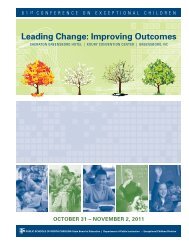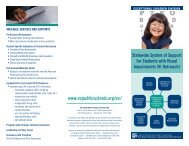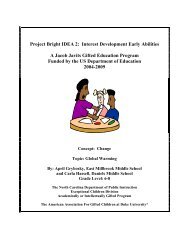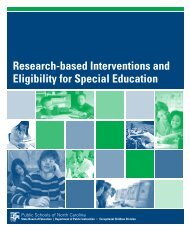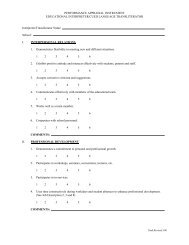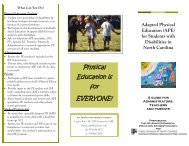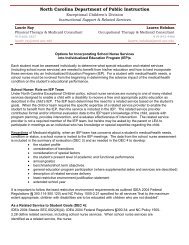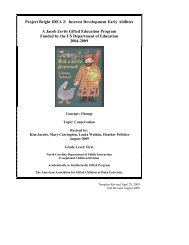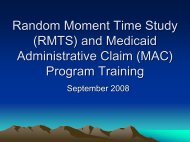Facilitating Visual Efficiency
Facilitating Visual Efficiency
Facilitating Visual Efficiency
You also want an ePaper? Increase the reach of your titles
YUMPU automatically turns print PDFs into web optimized ePapers that Google loves.
instruction in the selection and use of visual environmental modifications,<br />
including altering visual features in a typical environment so that a student can<br />
use his or her available vision to complete specific tasks with efficiency in<br />
that environment, (e.g., Holbrook & Koenig, 2000),<br />
instruction in the selection and use of assistive devices, including facilitating<br />
the use of non-optical, optical, and electronic assistive devices to complete<br />
specific tasks efficiently (e.g., Corn, Wall, & Bell, 2000; Corn et al, 2002;<br />
Smith, Huebner, & Leigh, 2002, Smith & Erin, 2002),<br />
instruction in the selection and use of sensory substitutions, including<br />
promoting the use of alternative sensory systems, such as audition or touch,<br />
when non-visual methods result in more efficient task completion than nonvisual<br />
methods (e.g., Corn & Koenig, 2002),<br />
instruction in methods to integrate information from all sensory systems,<br />
including encouraging awareness and coordinated use of all available sensory<br />
systems in ways unique to each student (Lueck & Heinze, 2004),<br />
instruction in low vision requires the implementation of systematic<br />
intervention techniques by the full team of professionals working with a<br />
student as well as the student's family so that instruction is reinforced within<br />
usual daily activities in school and in the home (Lueck, 2004).<br />
Recommended Practices<br />
Eligibility for special education services from a teacher of students with visual<br />
impairments and orientation and mobility (O&M) instructors requires that a student has a<br />
visual impairment, which, even with correction, adversely affects a student's educational<br />
performance (Individuals with Disabilities Education Improvement Act, 2004). Teachers<br />
of the students with visual impairments (TVIs) and certified orientation and mobility<br />
specialists (COMS) provide guidance in determining and implementing appropriate<br />
educational services related to low vision as part of a team that can include school staff,<br />
medical personnel, caregivers, and the student. Based upon the results of a general eye<br />
examination by an ophthalmologist or optometrist, a low vision evaluation by an<br />
ophthalmologist or optometrist, and functional vision evaluations by TVIs and certified<br />
O&M specialists, TVIs and certified O&M specialists assist the Individualized<br />
Education Program (IEP) team in determining which techniques related to vision use as<br />
well as techniques associated with other sensory systems best match the assessed needs<br />
of individual students. They provide guidance in establishing optimal techniques related<br />
to low vision to promote the achievement of benchmarks and objectives in more general<br />
IEP instructional areas. They also provide input in determining benchmarks and<br />
objectives specifically addressing low vision instruction for each student's education plan<br />
(including the expanded core curriculum for students with visual impairments), and<br />
determine ways to infuse this instruction into more general IEP goals whenever possible.<br />
This ensures that instruction related to low vision can be implemented by a variety of<br />
personnel and occurs regularly and repeatedly in functional activities throughout the day.<br />
Conclusion<br />
Comprehensive interventions in low vision include the promotion of visual skills<br />
and use, the selection and use of assistive devices, the selection and use of visual<br />
3




